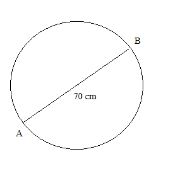
The diameter of the wheel of a car is \[70\;cm\]. How many revolutions will it make to travel \[1.65\;km\]?
Answer
565.2k+ views
Hint: Firstly with the help of radius find the circumference of the circle of the wheel as it gives the distance travelled by wheel in one revolution. Then divide the $ 1.65\;km $ by the circumference to find the number of revolutions.
Complete step-by-step answer:
The diameter of the wheel of a car is \[70\;cm\].

When we are solving this type of question, we need to follow the steps provided in the hint part above.
As we are given diameter = \[70\;cm\]
Radius =\[\dfrac{{70}}{2} = 35\;cm\]
Circumference of Wheel = \[2\pi r\]
r = radius = \[35\;cm\]
Circumference = \[2 \times \dfrac{{22}}{7} \times 35 = 44 \times 5\]
Circumference = \[220\;cm\]
The number of revolutions required is \[x\]. Then distance traveled by wheel \[(220)x\;cm\] as according to question distance travelled.
\[
\Rightarrow 1.65\;km = 1.65 \times 1000 = 1650\;m \\
\Rightarrow 1650\;m = 1650 \times 100\;cm = 165000\;cm \;
\]
[\[\because \]as we know that \[1\;km = {10^3}\;m\]and\[1\;m = 100\;cm\]]
Now \[(220)x\;cm\]should be equal to \[165000\]
\[
\Rightarrow (220)x = 165000 \\
x = \dfrac{{165000}}{{220}} = 750 \\
\]
Hence, \[750\] Revolution will make it to travel \[1.65\;km\]
Note: First thing to care in this is that no calculation mistakes are done for the circumference of the circle. Then take care of the units to convert the circumference into the given units. Then only move further once the units are matched.
Complete step-by-step answer:
The diameter of the wheel of a car is \[70\;cm\].

When we are solving this type of question, we need to follow the steps provided in the hint part above.
As we are given diameter = \[70\;cm\]
Radius =\[\dfrac{{70}}{2} = 35\;cm\]
Circumference of Wheel = \[2\pi r\]
r = radius = \[35\;cm\]
Circumference = \[2 \times \dfrac{{22}}{7} \times 35 = 44 \times 5\]
Circumference = \[220\;cm\]
The number of revolutions required is \[x\]. Then distance traveled by wheel \[(220)x\;cm\] as according to question distance travelled.
\[
\Rightarrow 1.65\;km = 1.65 \times 1000 = 1650\;m \\
\Rightarrow 1650\;m = 1650 \times 100\;cm = 165000\;cm \;
\]
[\[\because \]as we know that \[1\;km = {10^3}\;m\]and\[1\;m = 100\;cm\]]
Now \[(220)x\;cm\]should be equal to \[165000\]
\[
\Rightarrow (220)x = 165000 \\
x = \dfrac{{165000}}{{220}} = 750 \\
\]
Hence, \[750\] Revolution will make it to travel \[1.65\;km\]
Note: First thing to care in this is that no calculation mistakes are done for the circumference of the circle. Then take care of the units to convert the circumference into the given units. Then only move further once the units are matched.
Recently Updated Pages
Master Class 12 Business Studies: Engaging Questions & Answers for Success

Master Class 12 Economics: Engaging Questions & Answers for Success

Master Class 12 English: Engaging Questions & Answers for Success

Master Class 12 Maths: Engaging Questions & Answers for Success

Master Class 12 Social Science: Engaging Questions & Answers for Success

Master Class 12 Chemistry: Engaging Questions & Answers for Success

Trending doubts
Golden Revolution is related to AFood production BOil class 9 social science CBSE

Voters list is known as A Ticket B Nomination form class 9 social science CBSE

Which is the longest day and the shortest night in class 9 social science CBSE

Why did Aurangzeb ban the playing of the pungi Answer class 9 english CBSE

How do you find the valency of chlorine sulphur and class 9 chemistry CBSE

Define development




